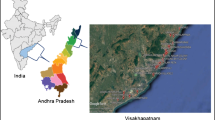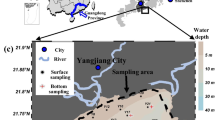Abstract
It is of great significance to evaluate the seawater intrusion degree and predict the change of water quality for coastal groundwater resources. This study takes Dagu River in Jiaodong Peninsula of North China as the target area and combines the relevant theoretical research results to build a seawater intrusion fuzzy analytic hierarchy process (AHP) evaluation model. Five sensitive indicators of water quality, such as Cl−, SO42−, NO3−, TH, and TDS, were selected to evaluate the seawater intrusion level of the long series monitoring data in Xilaiwan, Guanzhuang, and Ligezhuang of Dagu River Basin by using the basic fuzzy mathematics principles and the improved hierarchical analysis method. In this study, the cubic exponential smoothing method was applied to predict groundwater quality change in Dagu River Basin. In order to evaluate the change of seawater intrusion in detail and make timely prediction, this paper innovatively divided the classification standard of seawater intrusion degree based on relevant norms and scholars’ research and predicted the evaluation level of seawater intrusion by using long series historical observation data combined with fuzzy analytic hierarchy process. The cubic exponential smoothing method which has the characteristics of simple and fast was introduced to fit the observation elements, and the historical data were used to verify the prediction of the future development trend. Compared with the evaluation results of seawater intrusion by traditional methods, this study can reflect the whole development trend of seawater intrusion in detail and has the characteristics of more reasonable, accurate, and practical. It also provides a certain reference for the future seawater intrusion prevention. In addition to this case, the method proposed in this study will be applicable to a wider range of coastal zones, providing a new idea for the rational management and control of coastal groundwater resources.












Similar content being viewed by others
Data availability
Data will be made available on request.
References
Al-Juboori AM, Guven A (2016) A stepwise model to predict monthly streamflow. J Hydrol 543:283–292. https://doi.org/10.1016/j.jhydrol.2016.10.006
Aryafar A, Yousefi S et al (2013) The weight of interaction of mining activities: groundwater in environmental impact assessment using fuzzy analytical hierarchy process (FAHP). Environmental Earth Sciences 68(8):2313–2324. https://doi.org/10.1007/s12665-012-1910-x
Azarnivand A, Hashemi-Ma Da Ni FS et al (2015) “Extended fuzzy analytic hierarchy process approach in water and environmental management (case study: Lake Urmia Basin, Iran).” Environmental Earth Sciences 73 (1). https://doi.org/10.1007/s12665-014-3391-6
Chachadi AG, Lobo-Ferreira JP, Noronha L, Choudri BS (2003) Assessing the impact of sea-level rise on salt water intrusion in coastal aquifers using GALDIT. APRH/CEAS. Seminário Sobre Águas Subterrâneas, Lisbon (Feb 2003)
Chachadi AG, Lobo-Ferreira JP (2001) Seawater intrusion vulnerability mapping of aquifers using the GALDIT method. Coastin-A Coastal Policy Res Newsl 4:7–9
Chachadi AG, Lobo-Ferreira JP (2007) Assessing aquifer vulnerability to seawater intrusion using GALDIT method: part 2, GALDIT indicators description. Water Celt Countries Quant QualClim Var 310:172–180
Ge Y, Lou Y et al (2020) Spatial distribution and influencing factors on the variation of bacterial communities in an urban river sediment. Environmental Pollution 272:115984
Gontara M, Allouche N, Jmal I, Bouri S (2016) Sensitivity analysis for the GALDIT method based on the assessment of vulnerability to pollution in the northern Sfax coastal aquifer. Tunisia Environ Earth Sci 75:669. https://doi.org/10.1007/s12665-016-5459-y
Gorgij AD, Moghaddam AA (2016) Vulnerability assessment of saltwater intrusion using simplified GAPDIT method: a case study of Azarshahr Plain Aquifer, East Azerbaijan. Iran Arab J Geosci 9:106. https://doi.org/10.1007/s12517-015-2200-1
Jiansong A, Yunyang B et al (2018) Adaptive surrogate model based multiobjective optimization for coastal aquifer management. J Hydrol 561:98–111. https://doi.org/10.1016/j.jhydrol.2018.03.063
Jie DONG, Xin LI, Yun-Hai FANG et al (2020) Evaluation and prediction of groundwater quality based on improved fuzzy synthesis-exponential smoothing J7 In Chinese. Periodical of Ocean University of China 50(1):126–135
Kazakis N, Pavlou A et al (2016) Seawater intrusion mapping using electrical resistivity tomography and hydrochemical data. An application in the coastal area of eastern Thermaikos Gulf, Greece. Sci Total Environ 543(Pt A):373–387. https://doi.org/10.1016/j.scitotenv.2015.11.041
Khan M, Muhammad NS et al (2020) Wavelet based hybrid ANN-ARIMA models for meteorological drought forecasting. J Hydrol 590:125380. https://doi.org/10.1016/j.jhydrol.2020.125380
Kotti ME, Vlessidis AG et al (2005) Assessment of river water quality in Northwestern Greece. Water Resour Manage 19(1):77–94. https://doi.org/10.1007/s11269-005-0294-z
Lyu HM, Shen SL et al (2019) Risk assessment of mega-city infrastructures related to land subsidence using improved trapezoidal FAHP. Sci Total Environ 717:135310
Moazamnia M, Hassanzadeh Y, Nadiri AA, Sadeghfam S (2020) Vulnerability indexing to saltwater intrusion from models at two levels using artificial intelligence multiple model (AIMM). J Environ Manag 255:109871
Mohebbi MR, Saeedi R et al (2013) Assessment of water quality in groundwater resources of Iran using a modified drinking water quality index (DWQI). Ecological indicators 30(jul.):28–34. https://doi.org/10.1016/j.ecolind.2013.02.008
Moon, Seong et al (2006) “application of grey model and artificial neural networks to flood forecasting.” Journal of the American Water Resources Association. https://doi.org/10.1111/j.1752-1688.2006.tb03851.x
Panahi M, Gayen A et al (2020) Spatial prediction of landslide susceptibility using hybrid support vector regression (SVR) and the adaptive neuro-fuzzy inference system (ANFIS) with various metaheuristic algorithms. Sci Total Environ 741:139937. https://doi.org/10.1016/j.scitotenv.2020.139937
Pandhiani SM, Shabri AB (2013) Time series forecasting using wavelet-least squares support vector machines and wavelet regression models for monthly stream flow data. Journal of Nonparametric Statistics 3(3):12. https://doi.org/10.4236/ojs.2013.33021
Qiu M, Huang F et al (2020) “Prediction model of water yield property based on GRA, FAHP and TOPSIS methods for Ordovician top aquifer in the Xinwen coalfield of China.” Environmental Earth Sciences 79 (10).
Reyhaneh S, Abbas R et al (2019) Risk analysis of urban stormwater infrastructure systems using fuzzy spatial multi-criteria decision making. Sci Total Environ 647:1468–1477
Ribas JR, Pérez-Díaz JI (2019) “A multicriteria fuzzy approximate reasoning approach for risk assessment of dam safety.” Environ Earth Sci
Saaty LT (1986) Axiomatic foundation of the analytic hierarchy process. Management Science 32(7):841–855
Saaty TL, Kearns KP (1985) “The analytic hierarchy process.” analytical planning
Sadeghfam S, Hassanzadeh Y, Nadiri AA, Zarghami M (2016) Localization of Groundwater Vulnerability Assessment Using Catastrophe Theory. Water Resour Manag 30(13):4585–4601. https://doi.org/10.1007/s11269-016-1440-5
Sadeghfam S, Khatibi RH, Daneshfaraz R et al (2020) Transforming vulnerability indexing for saltwater intrusion into risk indexing through a fuzzy catastrophe scheme[J]. Water Resour Manage 34(1):175–194
Sun WC, Chung IM et al (2020) “Vulnerability assessment considering impact of future groundwater exploitation on coastal groundwater resources in northeastern Jeju Island, South Korea.” Environ Earth Sci 79 (22)
Tran DA, Tsujimura M et al (2021) Evaluating the predictive power of different machine learning algorithms for groundwater salinity prediction of multi-layer coastal aquifers in the Mekong Delta, Vietnam. Ecol Ind 127:107790. https://doi.org/10.1016/j.ecolind.2021.107790
Tu xiangyang and Gao xueping (2003) Application of fuzzy mathematics in evaluation of groundwater quality by seawater intrusion. J Hydraul Eng 08:64–69 (in Chinese)
Valipour M, Banihabib ME et al (2013) “Comparison of the ARMA, ARIMA, and the autoregressive artificial neural network models in forecasting the monthly inflow of Dez dam reservoir.” J Hydrol 476.https://doi.org/10.1016/j.jhydrol.2012.11.017
Vorosmarty C et al (2000) “Global water resources: vulnerability from climate change and population growth.” Science
Xiong G, An Q et al (2020) Evolution analysis and environmental management of intruded aquifers of the Dagu River Basin of China. Sci Total Environ 719:137260. https://doi.org/10.1016/j.scitotenv.2020.137260
Xza B, Zya B et al (2020) “Evaluation of hydrogeological impact of tunnel engineering in a karst aquifer by coupled discrete-continuum numerical simulations.” J Hydrol
Yin Z, Luo Q et al (2020) Identification of the long-term variations of groundwater and their governing factors based on hydrochemical and isotopic data in a river basin. J Hydrol 592:125604. https://doi.org/10.1016/j.jhydrol.2020.125604
Yu W, Chao Jia, Han Yuan et al (2018) Evaluation of water ecological civilization construction based on improved AHP and matter element extension method [J]. Water Sci Eng Technol 1:6
Zeng X, Wu J et al (2016) Assessing the pollution risk of a groundwater source field at western Laizhou Bay under seawater intrusion. Environ Res 148:586–594. https://doi.org/10.1016/j.envres.2015.11.022
Zhang D, Yang Y et al (2020) Global sensitivity analysis on a numerical model of seawater intrusion and its implications for coastal aquifer management: a case study in Dagu River Basin, Jiaozhou Bay, China. Hydrogeol J. https://doi.org/10.1007/s10040-020-02219-6
Zhou W, Wu X et al (2020) “Predictive analysis of the air quality indicators in the Yangtze River Delta in China: an application of a novel seasonal grey model.” Sci Total Environ: 141428. https://doi.org/10.1016/j.scitotenv.2020.141428
Zhou C, Chen X et al (2019) “Predicting energy consumption: a multiple decomposition-ensemble approach.” Energy 189
Author information
Authors and Affiliations
Contributions
All of the parts of this research were conducted by Professor Jia; Haitao Yang conducted the research. Haitao Yang and Xin li performed statistical analysis; Haitao Yang wrote the paper; Fan Yang, Cong Wang, and Xiao Yang revised this paper. All authors have read and approved the final manuscript.
Corresponding author
Ethics declarations
Ethics approval and consent to participate
Not applicable.
Consent for publication
Not applicable.
Competing interests
The authors declare no competing interests.
Disclaimer
The funder did not play any role in study design; in the collection, analysis, and interpretation of data; in the writing of the report; nor in the preparation, review, or approval of the manuscript.
Additional information
Responsible Editor: Xianliang Yi
Publisher's note
Springer Nature remains neutral with regard to jurisdictional claims in published maps and institutional affiliations.
Rights and permissions
About this article
Cite this article
Yang, H., Jia, C., Li, X. et al. Evaluation of seawater intrusion and water quality prediction in Dagu River of North China based on fuzzy analytic hierarchy process exponential smoothing method. Environ Sci Pollut Res 29, 66160–66176 (2022). https://doi.org/10.1007/s11356-022-19871-y
Received:
Accepted:
Published:
Issue Date:
DOI: https://doi.org/10.1007/s11356-022-19871-y




